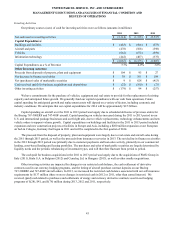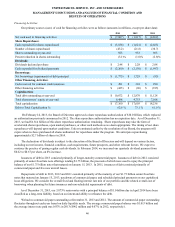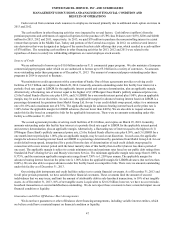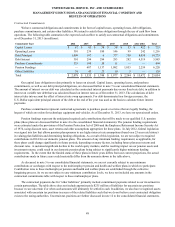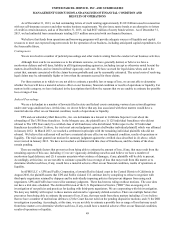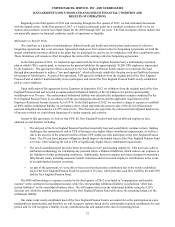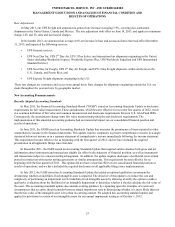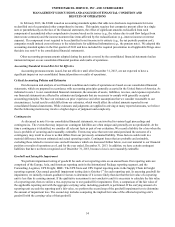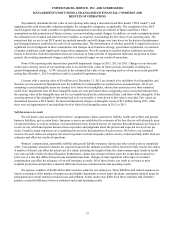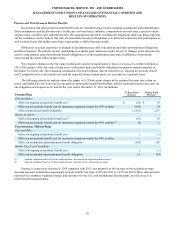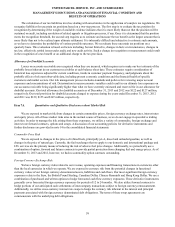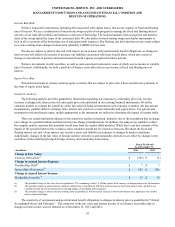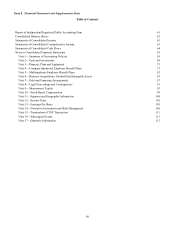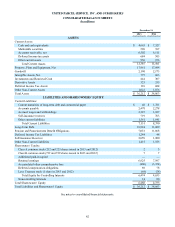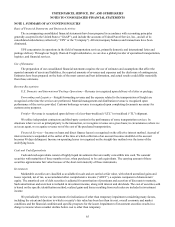UPS 2013 Annual Report Download - page 67
Download and view the complete annual report
Please find page 67 of the 2013 UPS annual report below. You can navigate through the pages in the report by either clicking on the pages listed below, or by using the keyword search tool below to find specific information within the annual report.UNITED PARCEL SERVICE, INC. AND SUBSIDIARIES
MANAGEMENT'S DISCUSSION AND ANALYSIS OF FINANCIAL CONDITION AND
RESULTS OF OPERATIONS
55
We primarily determine the fair value of our reporting units using a discounted cash flow model (“DCF model”), and
supplement this with observable valuation multiples for comparable companies, as applicable. The completion of the DCF
model requires that we make a number of significant assumptions to produce an estimate of future cash flows. These
assumptions include projections of future revenue, costs and working capital changes. In addition, we make assumptions about
the estimated cost of capital and other relevant variables, as required, in estimating the fair value of our reporting units. The
projections that we use in our DCF model are updated annually and will change over time based on the historical performance
and changing business conditions for each of our reporting units. The determination of whether goodwill is impaired involves a
significant level of judgment in these assumptions, and changes in our business strategy, government regulations, or economic
or market conditions could significantly impact these judgments. We will continue to monitor market conditions and other
factors to determine if interim impairment tests are necessary in future periods. If impairment indicators are present in future
periods, the resulting impairment charges could have a material impact on our results of operations.
None of the reporting units incurred any goodwill impairment charges in 2013, 2012 or 2011. Changes in our forecasts
could cause carrying values of our reporting units to exceed their fair values in future periods, potentially resulting in a
goodwill impairment charge. A 10% decrease in the estimated fair value of our reporting units as of our most recent goodwill
testing date (October 1, 2013) would not result in a goodwill impairment charge.
Licenses with a carrying value of $5 million as of December 31, 2013 are deemed to be indefinite-lived intangibles, and
therefore are not amortized. Impairment tests for indefinite-lived intangibles are performed on an annual basis. All of our
remaining recorded intangible assets are deemed to be finite-lived intangibles, and are thus amortized over their estimated
useful lives. Impairment tests for these intangible assets are only performed when a triggering event occurs that indicates that
the carrying value of the intangible may not be recoverable based on the undiscounted future cash flows of the intangible. If the
carrying amount of the intangible is determined not to be recoverable, a write-down to fair value is recorded. Fair values are
determined based on a DCF model. We incurred impairment charges on intangible assets of $13 million during 2013, while
there were no impairments of any indefinite-lived or finite-lived intangible assets in 2012 or 2011.
Self-Insurance Accruals
We self-insure costs associated with workers’ compensation claims, automotive liability, health and welfare and general
business liabilities, up to certain limits. Insurance reserves are established for estimates of the loss that we will ultimately incur
on reported claims, as well as estimates of claims that have been incurred but not yet reported. Recorded balances are based on
reserve levels, which incorporate historical loss experience and judgments about the present and expected levels of cost per
claim. Trends in actual experience are a significant factor in the determination of such reserves. We believe our estimated
reserves for such claims are adequate, but actual experience in claim frequency and/or severity could materially differ from our
estimates and affect our results of operations.
Workers’ compensation, automobile liability and general liability insurance claims may take several years to completely
settle. Consequently, actuarial estimates are required to project the ultimate cost that will be incurred to fully resolve the claims.
A number of factors can affect the actual cost of a claim, including the length of time the claim remains open, trends in health
care costs and the results of related litigation. Furthermore, claims may emerge in future years for events that occurred in a
prior year at a rate that differs from previous actuarial projections. Changes in state legislation with respect to workers'
compensation can affect the adequacy of our self-insurance accruals. All of these factors can result in revisions to prior
actuarial projections and produce a material difference between estimated and actual operating results.
We sponsor a number of health and welfare insurance plans for our employees. These liabilities and related expenses are
based on estimates of the number of employees and eligible dependents covered under the plans, anticipated medical usage by
participants and overall trends in medical costs and inflation. Actual results may differ from these estimates and, therefore,
produce a material difference between estimated and actual operating results.


